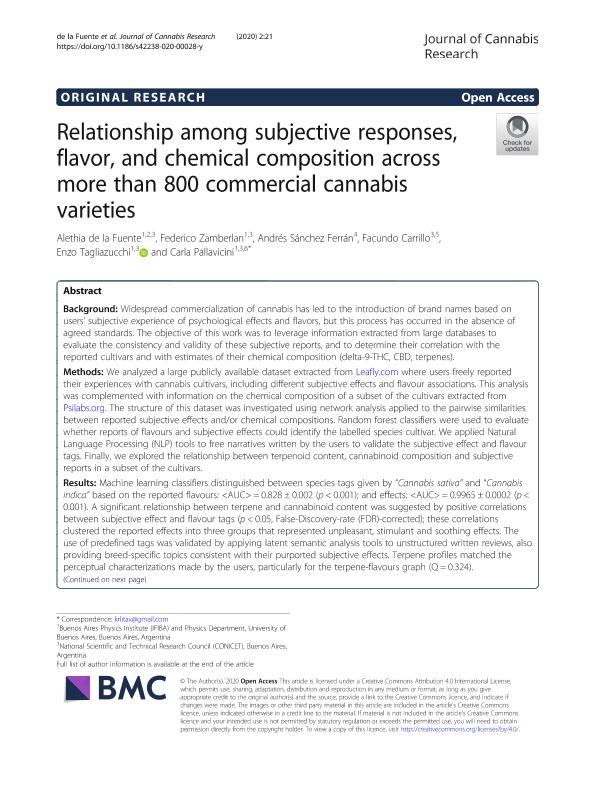Artículo
Relationship among subjective responses, flavor, and chemical composition across more than 800 commercial cannabis varieties
de la Fuente de la Torre, Laura Alethia ; Zamberlan, Federico
; Zamberlan, Federico ; Sánchez Ferrán, Andrés; Carrillo, Facundo
; Sánchez Ferrán, Andrés; Carrillo, Facundo ; Tagliazucchi, Enzo Rodolfo
; Tagliazucchi, Enzo Rodolfo ; Pallavicini, Carla
; Pallavicini, Carla
 ; Zamberlan, Federico
; Zamberlan, Federico ; Sánchez Ferrán, Andrés; Carrillo, Facundo
; Sánchez Ferrán, Andrés; Carrillo, Facundo ; Tagliazucchi, Enzo Rodolfo
; Tagliazucchi, Enzo Rodolfo ; Pallavicini, Carla
; Pallavicini, Carla
Fecha de publicación:
07/2020
Editorial:
BioMed Central
Revista:
Journal of Cannabis Research
ISSN:
2522-5782
Idioma:
Inglés
Tipo de recurso:
Artículo publicado
Clasificación temática:
Resumen
Background: Widespread commercialization of cannabis has led to the introduction of brand names based onusers? subjective experience of psychological effects and flavors, but this process has occurred in the absence ofagreed standards. The objective of this work was to leverage information extracted from large databases toevaluate the consistency and validity of these subjective reports, and to determine their correlation with thereported cultivars and with estimates of their chemical composition (delta-9-THC, CBD, terpenes).Methods: We analyzed a large publicly available dataset extracted from Leafly.com where users freely reportedtheir experiences with cannabis cultivars, including different subjective effects and flavour associations. This analysiswas complemented with information on the chemical composition of a subset of the cultivars extracted fromPsilabs.org. The structure of this dataset was investigated using network analysis applied to the pairwise similaritiesbetween reported subjective effects and/or chemical compositions. Random forest classifiers were used to evaluatewhether reports of flavours and subjective effects could identify the labelled species cultivar. We applied NaturalLanguage Processing (NLP) tools to free narratives written by the users to validate the subjective effect and flavourtags. Finally, we explored the relationship between terpenoid content, cannabinoid composition and subjectivereports in a subset of the cultivars.Results: Machine learning classifiers distinguished between species tags given by ?Cannabis sativa? and ?Cannabisindica? based on the reported flavours: <AUC> = 0.828 ± 0.002 (p < 0.001); and effects: <AUC> = 0.9965 ± 0.0002 (p <0.001). A significant relationship between terpene and cannabinoid content was suggested by positive correlationsbetween subjective effect and flavour tags (p < 0.05, False-Discovery-rate (FDR)-corrected); these correlationsclustered the reported effects into three groups that represented unpleasant, stimulant and soothing effects. Theuse of predefined tags was validated by applying latent semantic analysis tools to unstructured written reviews, alsoproviding breed-specific topics consistent with their purported subjective effects. Terpene profiles matched theperceptual characterizations made by the users, particularly for the terpene-flavours graph (Q = 0.324).
Palabras clave:
CANNABIS
,
CANNABINOIDS
,
TERPENES
,
FLAVOUR
Archivos asociados
Licencia
Identificadores
Colecciones
Articulos(ICC)
Articulos de INSTITUTO DE INVESTIGACION EN CIENCIAS DE LA COMPUTACION
Articulos de INSTITUTO DE INVESTIGACION EN CIENCIAS DE LA COMPUTACION
Articulos(IFIBA)
Articulos de INST.DE FISICA DE BUENOS AIRES
Articulos de INST.DE FISICA DE BUENOS AIRES
Articulos(INCYT)
Articulos de INSTITUTO DE NEUROCIENCIAS COGNITIVAS Y TRASLACIONAL
Articulos de INSTITUTO DE NEUROCIENCIAS COGNITIVAS Y TRASLACIONAL
Citación
de la Fuente de la Torre, Laura Alethia; Zamberlan, Federico; Sánchez Ferrán, Andrés; Carrillo, Facundo; Tagliazucchi, Enzo Rodolfo; et al.; Relationship among subjective responses, flavor, and chemical composition across more than 800 commercial cannabis varieties; BioMed Central; Journal of Cannabis Research; 2; 1; 7-2020; 1-18
Compartir
Altmétricas



